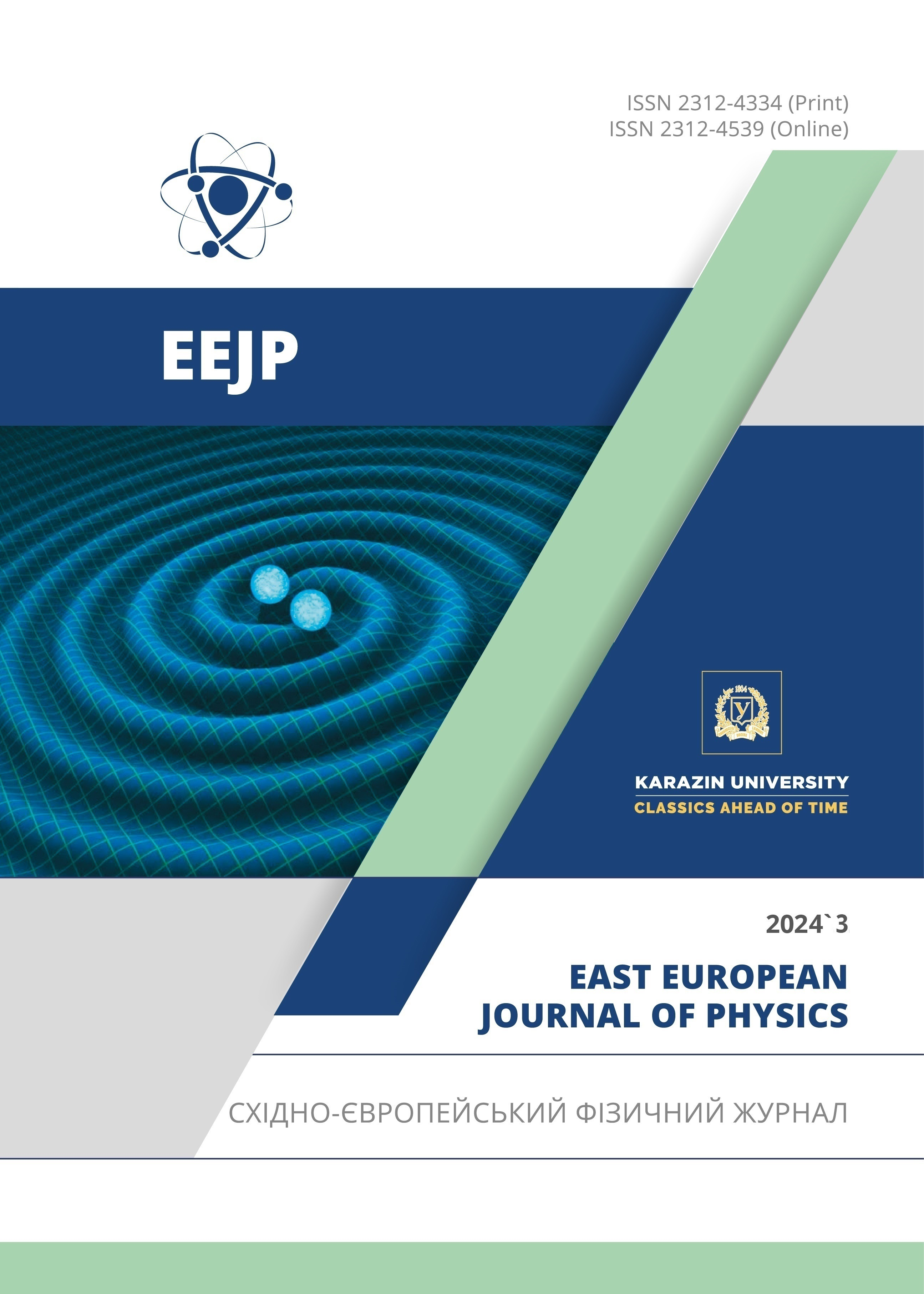Фотоелектричні характеристики гетеропереходу n-GaAs-p-(GaAs)1-x-y(Ge2)x(ZnSe)y
Анотація
Досліджено фотоелектричні властивості гетероструктур n-GaAs – p-(GaAs)1–x–y(Ge2)x(ZnSe)y як у фотодіодному, так і у фотоелектричному режимах. Виявлено, що спектральна залежність фотоструму охоплює широкий діапазон енергетичних інтервалів від 1,07 еВ до 3 еВ. Показано, що з підвищенням температури початку кристалізації (Toc) піки спектральних залежностей фотоелектрорушійної сили (фото-ЕРС) зміщуються в бік коротших довжин хвиль. Було помічено, що зі збільшенням температури початку кристалізації (Toc) шару твердого розчину (GaAs)1–x–y(Ge2)x(ZnSe)y час життя фотоносіїв збільшується з 10-7 с при Toc= 650°C до 5·10-5 с при Toc=730°C. Показано, що піки власної смуги фотолюмінесценції зміщуються в бік коротших довжин хвиль зі збільшенням температури початку кристалізації. Крім того, дослідження власної спектральної області фотолюмінесценції зразків по товщині епітаксійного шару підтверджує варіабельність отриманих структур.
Завантаження
Посилання
W. Yang at. el, “Pseudobinary Solid-Solution: An Alternative Way for the Bandgap Engineering of Semiconductor Nanowires in the Case of GaP–ZnSe,” Advanced Functional Materials, 25(17), 2543 (2015). https://doi.org/10.1002/adfm.201404523
A. Kosarev, V. Chaldysheva, V. Preobrazhenskii, M. Putyato, and B. Semyagin. “Effect of a Low-Temperature-Grown GaAs Layer on InAs Quantum-Dot Photoluminescence,” Semiconductors, 50(11), 1519 (2016). https://doi.org/10.1134/S1063782616110154
M. Szot, et al. “Experimental and Theoretical Analysis οf PbTe-CdTe Solid Solution Grown by Physical Vapour Transport Method,” Acta Physica Polonica A, 116(5), 959 (2009).
A. Reznitskya, A. Klochikhina, and M. Eremenko. “Thermally Activated Resonance Tunneling in Asymmetric Systems of CdSe/ZnSe Double Quantum Wells with Self Assembled Quantum Dots,” Semiconductors, 48(3), 345 (2014). https://doi.org/10.1134/S1063782614030221
A. Sharma, and T. Das. “Electronic band structure and optical properties of GaAsSb/GaAs for optoelectronic device applications: A 14 band k.p study,” Optical Materials, 112, 110734 (2021). https://doi.org/10.1016/j.optmat.2020.110734
P. Sanmartin, F. Almonacid, M. Ceballos, A. Garcia-Loureiro, and E. Fernandez, “Wide-bandgap III-V materials for high efficiency air and underwater optical photovoltaic power transmission,” Solar Energy Materials and Solar Cells, 266, 112662 (2024). https://doi.org/10.1016/j.solmat.2023.112662
A. Yachmenev, S. Pushkarev, R. Reznik, R. Khabibullin, and D. Ponomarev, “Arsenides-and related III-V materials-based multilayered structures for terahertz applications: Various designs and growth technology,” Progress in Crystal Growth and Characterization of Materials, 66, 100485 (2020). https://doi.org/10.1016/j.pcrysgrow.2020.100485Get rights and content
N. Papez, R. Dallaev, ¸S. Talu, and J. Kastyl. “Overview of the Current State of Gallium Arsenide-Based Solar Cells (Review),” Materials, 14, 3075 (2021). https://doi.org/10.3390/ma14113075
J. Geisz, R. France, K. Schulte, M. Steiner, A. Norman, H. Guthrey, M. Young, et al., “Six-junction III–V solar cells with 47.1% under 143 Suns concentration,” Nat. Energy, 5(4), 326–335 (2020). https://doi.org/10.1038/s41560-020-0598-5
S. Zaynabidinov, A. Saidov, A. Boboev, and D. Abdurahimov, “Structure, Morphology and Photoelectric Properties of n-GaAs-p-(GaAs)1--x(Ge2)х Heterostructure,” Herald of the Bauman Moscow State Technical University, Series Natural Sciences, 100(1), 72-87 (2022). https://doi.org/10.18698/1812-3368-2022-1-72-87
S. Zainabidinov, A. Saidov, M. Kalanov, and A. Boboev, “Synthesis, Structure and Electro-Physical Properties n-GaAs–p-(GaAs)1–x–y(Ge2)x(ZnSe)y Heterostructures (Review)”. Applied Solar Energy, 55, 291–308 (2019). https://doi.org/10.1038/s41560-020-0598-510.3103/S0003701X1905013X
S. Suprun, V. Sherstyakova, and E. Fedosenko. “Epitaxial Growth of ZnSe on GaAs with the Use of the ZnSe Compound as the Source”. Semiconductors, 43(11),1526–1531(2009) https://doi.org/10.1134/S1063782609110220
S. Khludkov, O. Tolbanov, M. Vilisova, and I. Prudaev, Semiconductor devices based on gallium arsenide with deep impurity centers, (Publishing House of Tomsk State University, Tomsk, 2016).
D. Bletskan, J. Madyar, and V. Kabaciy, “Effect of Nonstoichiometry and Doping on the Photoconductivity Spectra of GeSe Layered Crystals,” Semiconductors, 40(2), 137–142 (2006) https://doi.org/10.1134/S1063782606020047.
S. Zainabidinov, Sh. Utamuradova, and A. Boboev, “Structural Peculiarities of the (ZnSe)1–x–y(Ge2)x(GaAs1–δBiδ)y Solid Solution with Various Nanoinclusions,” Journal of Surface Investigation X-ray Synchrotron and Neutron Techniques, 16(6), 1130-1134 (2022). https://doi.org/10.1134/S1027451022060593
Авторське право (c) 2024 Акрамжон Ю. Бобоєв

Цю роботу ліцензовано за Міжнародня ліцензія Creative Commons Attribution 4.0.
Автори, які публікуються у цьому журналі, погоджуються з наступними умовами:
- Автори залишають за собою право на авторство своєї роботи та передають журналу право першої публікації цієї роботи на умовах ліцензії Creative Commons Attribution License, котра дозволяє іншим особам вільно розповсюджувати опубліковану роботу з обов'язковим посиланням на авторів оригінальної роботи та першу публікацію роботи у цьому журналі.
- Автори мають право укладати самостійні додаткові угоди щодо неексклюзивного розповсюдження роботи у тому вигляді, в якому вона була опублікована цим журналом (наприклад, розміщувати роботу в електронному сховищі установи або публікувати у складі монографії), за умови збереження посилання на першу публікацію роботи у цьому журналі.
- Політика журналу дозволяє і заохочує розміщення авторами в мережі Інтернет (наприклад, у сховищах установ або на особистих веб-сайтах) рукопису роботи, як до подання цього рукопису до редакції, так і під час його редакційного опрацювання, оскільки це сприяє виникненню продуктивної наукової дискусії та позитивно позначається на оперативності та динаміці цитування опублікованої роботи (див. The Effect of Open Access).








